Marangoni Boundary Layer Flow and Heat Transfer of Graphene–Water Nanofluid with Particle Shape Effects
Abstract
1. Introduction
2. Description of the Problem
3. Solution Methodology
4. Comparison of Results and Discussion
5. Concluding Remarks
- The accuracy of the numerical results has been verified with analytical results.
- The nanoparticles of lamina shape play a significant role in the disturbance of temperature profile.
- The nanoparticles of sphere shape play the smallest role in the disturbance of temperature profile.
- The nanoparticles of sphere shape play a remarkable role in the rate of heat transfer.
- The nanoparticles of lamina shape play the smallest role in the heat transfer rate.
Author Contributions
Funding
Acknowledgments
Conflicts of Interest
Abbreviations
| PDEs | Partial differential equations |
| ODEs | Ordinary differential equations |
| DEs | Differential equations |
| HAM | Homotopy analysis method |
References
- Novoselov, K.; Geim, A.K.; Morozov, S.; Jiang, D.; Zhang, Y.; Dubonos, S.V.; Grigorieva, I.V.; Firsov, A.A. Electric Field Effect in Atomically Thin Carbon Films. Science 2004, 306, 666–669. [Google Scholar] [CrossRef]
- Yu, X.; Wu, Q.; Zhang, H.; Zeng, G.; Li, W.; Qian, Y.; Li, Y.; Yang, G.; Chen, M. Investigation on synthesis, stability, and thermal conductivity properties of water-based SnO2/reduced graphene oxide nanofluids. Materials 2017, 11, 38. [Google Scholar] [CrossRef]
- Rehman, A.; Salleh, Z.; Gul, T.; Zaheer, Z. The Impact of Viscous Dissipation on the Thin Film Unsteady Flow of GO-EG/GO-W Nanofluids. Mathematics 2019, 7, 653. [Google Scholar] [CrossRef]
- Aly, E.H. Dual exact solutions of graphene–water nanofluid flow over stretching/shrinking sheet with suction/injection and heat source/sink: Critical values and regions with stability. Powder Technol. 2019, 342, 528–544. [Google Scholar] [CrossRef]
- Upadhya, S.M.; Raju, C.S.K.; Saleem, S.; Alderremy, A. Mahesha Modified Fourier heat flux on MHD flow over stretched cylinder filled with dust, Graphene and silver nanoparticles. Results Phys. 2018, 9, 1377–1385. [Google Scholar] [CrossRef]
- Upadhya, S.M.; Mahesha; Raju, C.S.K. Unsteady Flow of Carreau Fluid in a Suspension of Dust and Graphene Nanoparticles With Cattaneo–Christov Heat Flux. J. Heat Transf. 2018, 140, 092401. [Google Scholar] [CrossRef]
- Khan, N.S.; Zuhra, S. Boundary layer flow and heat transfer in a thin-film second-grade nanoliquid embedded with graphene nanoparticles. Adv. Mech. Eng. 2019, 11, 1–11. [Google Scholar] [CrossRef]
- Shit, G.C.; Mukherjee, S. MHD graphene-polydimethylsiloxane Maxwell nanofluid flow in a squeezing channel with thermal radiation effects. Appl. Math. Mech. 2019, 40, 1269–1284. [Google Scholar] [CrossRef]
- Arif, M.; Ali, F.; Sheikh, N.A.; Khan, I. Enhanced heat transfer in working fluids using nanoparticles with ramped wall temperature: Applications in engine oil. Adv. Mech. Eng. 2019, 11, 1–11. [Google Scholar] [CrossRef]
- Periasamy, S.M.; Baskar, R. Assessment of the Influence of Graphene Nanoparticles on Thermal Conductivity of Graphene/Water Nanofluids Using Factorial Design of Experiments. Period. Polytech. Chem. Eng. 2018, 62, 317–322. [Google Scholar] [CrossRef]
- Azimi, M.; Riazi, R. Heat transfer analysis of GO-water nanofluid flow between two parallel disks. Propuls. Power Res. 2015, 4, 23–30. [Google Scholar] [CrossRef]
- Moosavi, M.; Momeni, M.; Tavangar, T.; Mohammadyari, R.; Rahimi-Esbo, M. Variational iteration method for flow of non-Newtonian fluid on a moving belt and in a collector. Alex. Eng. J. 2016, 55, 1775–1783. [Google Scholar] [CrossRef]
- Maghsoudi, P.; Shahriari, G.; Rasam, H.; Sadeghi, S. Flow and natural convection heat transfer characteristics of non-Newtonian nanofluid flow bounded by two infinite vertical flat plates in presence of magnetic field and thermal radiation using Galerkin method. J. Cent. South Univ. 2019, 26, 1294–1305. [Google Scholar] [CrossRef]
- Aliy, G.; Kishan, N. Optimal Homotopy Asymptotic Solution for Cross-Diffusion Effects on Slip Flow and Heat Transfer of Electrical MHD Non-Newtonian Fluid Over a Slendering Stretching Sheet. Int. J. Appl. Comput. Math. 2019, 5, 80. [Google Scholar] [CrossRef]
- Freidoonimehr, N.; Rostami, B.; Rashidi, M. Predictor homotopy analysis method for nanofluid flow through expanding or contracting gaps with permeable walls. Int. J. Biomath. 2015, 8, 1550050. [Google Scholar] [CrossRef]
- Usman, M.; Hamid, M.; Khan, U.; Din, S.T.M.; Iqbal, M.A.; Wang, W. Differential transform method for unsteady nanofluid flow and heat transfer. Alex. Eng. J. 2018, 57, 1867–1875. [Google Scholar] [CrossRef]
- Eldabe, N.; Abou-Zeid, M. Homotopy perturbation method for MHD pulsatile non-Newtonian nanofluid flow with heat transfer through a non-Darcy porous medium. J. Egypt. Math. Soc. 2017, 25, 375–381. [Google Scholar] [CrossRef]
- Bakodah, H.O.; Ebaid, A. The Adomian decomposition method for the slip flow and heat transfer of nanofluids over a stretching/shrinking sheet. Rom. Rep. Phys. 2018, 70, 115. [Google Scholar]
- Al-Mudhaf, A.; Chamkha, A.J. Similarity solutions for MHD thermosolutal Marangoni convection over a flat surface in the presence of heat generation or absorption effects. Heat Mass Transf. 2005, 42, 112–121. [Google Scholar] [CrossRef]
- Zhang, Y.; Zheng, L.; Liu, J. Approximate Analytical Solutions for Marangoni Mixed Convection Boundary Layer. In Proceedings of the 4th International Heat Transfer Conference, Washington, DC, USA, 8–13 August 2010; pp. 413–417. [Google Scholar] [CrossRef]
- Christopher, D.; Wang, B.-X. Marangoni Convection Around a Bubble In Microgravity. Heat Transf. 1998, 3, 489–494. [Google Scholar] [CrossRef]
- Straub, J. The role of surface tension for two-phase heat and mass transfer in the absence of gravity. Exp. Therm. Fluid Sci. 1994, 9, 253–273. [Google Scholar] [CrossRef]
- Pop, I.; Postelnicu, A.; Grosan, T. Thermosolutal Marangoni Forced Convection Boundary Layers. Meccanica 2001, 36, 555–571. [Google Scholar] [CrossRef]
- Golia, C.; Viviani, A. Non isobaric boundary layers related to Marangoni flows. Meccanica 1986, 21, 200–204. [Google Scholar] [CrossRef]
- Christopher, D.M.; Wang, B. Prandtl number effects for Marangoni convection over a flat surface. Int. J. Therm. Sci. 2001, 40, 564–570. [Google Scholar] [CrossRef]
- Chamkha, A.J.; Pop, I.; Takhar, H. Marangoni Mixed Convection Boundary Layer Flow. Meccanica 2006, 41, 219–232. [Google Scholar] [CrossRef]
- Magyari, E.; Chamkha, A. Exact analytical results for the thermosolutal MHD Marangoni boundary layers. Int. J. Therm. Sci. 2008, 47, 848–857. [Google Scholar] [CrossRef]
- Arafune, K.; Hirata, A. Thermal and solutal Marangoni convection in In–Ga–Sb system. J. Cryst. Growth 1999, 197, 811–817. [Google Scholar] [CrossRef]
- Lin, Y.; Li, B.; Zheng, L.; Chen, G. Particle shape and radiation effects on Marangoni boundary layer flow and heat transfer of copper-water nanofluid driven by an exponential temperature. Powder Technol. 2016, 301, 379–386. [Google Scholar] [CrossRef]
- Aly, E.; Ebaid, A. Exact analysis for the effect of heat transfer on MHD and radiation Marangoni boundary layer nanofluid flow past a surface embedded in a porous medium. J. Mol. Liq. 2016, 215, 625–639. [Google Scholar] [CrossRef]
- Hayat, T.; Khan, M.I.; Farooq, M.; Alsaedi, A.; Yasmeen, T. Impact of Marangoni convection in the flow of carbon–water nanofluid with thermal radiation. Int. J. Heat Mass Transf. 2017, 106, 810–815. [Google Scholar] [CrossRef]
- Sheikholeslami, M.; Chamkha, A.J. Influence of Lorentz forces on nanofluid forced convection considering Marangoni convection. J. Mol. Liq. 2017, 225, 750–757. [Google Scholar] [CrossRef]
- Bognár, G.; Hriczó, K. Series Solutions for Marangoni Convection on a Vertical Surface. Math. Probl. Eng. 2012, 2012, 1–18. [Google Scholar] [CrossRef]
- Yan, Z.; Liancun, Z.; Xiaojing, W.; Guhua, S. Analysis of Marangoni convection of non-Newtonian power law fluids with linear temperature distribution. Therm. Sci. 2011, 15, 45–52. [Google Scholar] [CrossRef]
- Lin, Y.; Zheng, L. Marangoni boundary layer flow and heat transfer of copper-water nanofluid over a porous medium disk. AIP Adv. 2015, 5, 107225. [Google Scholar] [CrossRef]
- Kandasamy, R.; Adnan, N.A.B.; Mohammad, R. Nanoparticle shape effects on squeezed MHD flow of water based Cu, Al2O3 and SWCNTs over a porous sensor surface. Alex. Eng. J. 2018, 57, 1433–1445. [Google Scholar] [CrossRef]
- Rashid, U.; Ibrahim, A. Impacts of Nanoparticle Shape on Al2O3-Water Nanofluid Flow and Heat Transfer over a Non-Linear Radically Stretching Sheet. Adv. Nanoparticles 2020, 9, 23–39. [Google Scholar] [CrossRef]
- Aman, S.; Khan, I.; Ismail, Z.; Salleh, M.Z. Impacts of gold nanoparticles on MHD mixed convection Poiseuille flow of nanofluid passing through a porous medium in the presence of thermal radiation, thermal diffusion and chemical reaction. Neural Comput. Appl. 2016, 30, 789–797. [Google Scholar] [CrossRef]

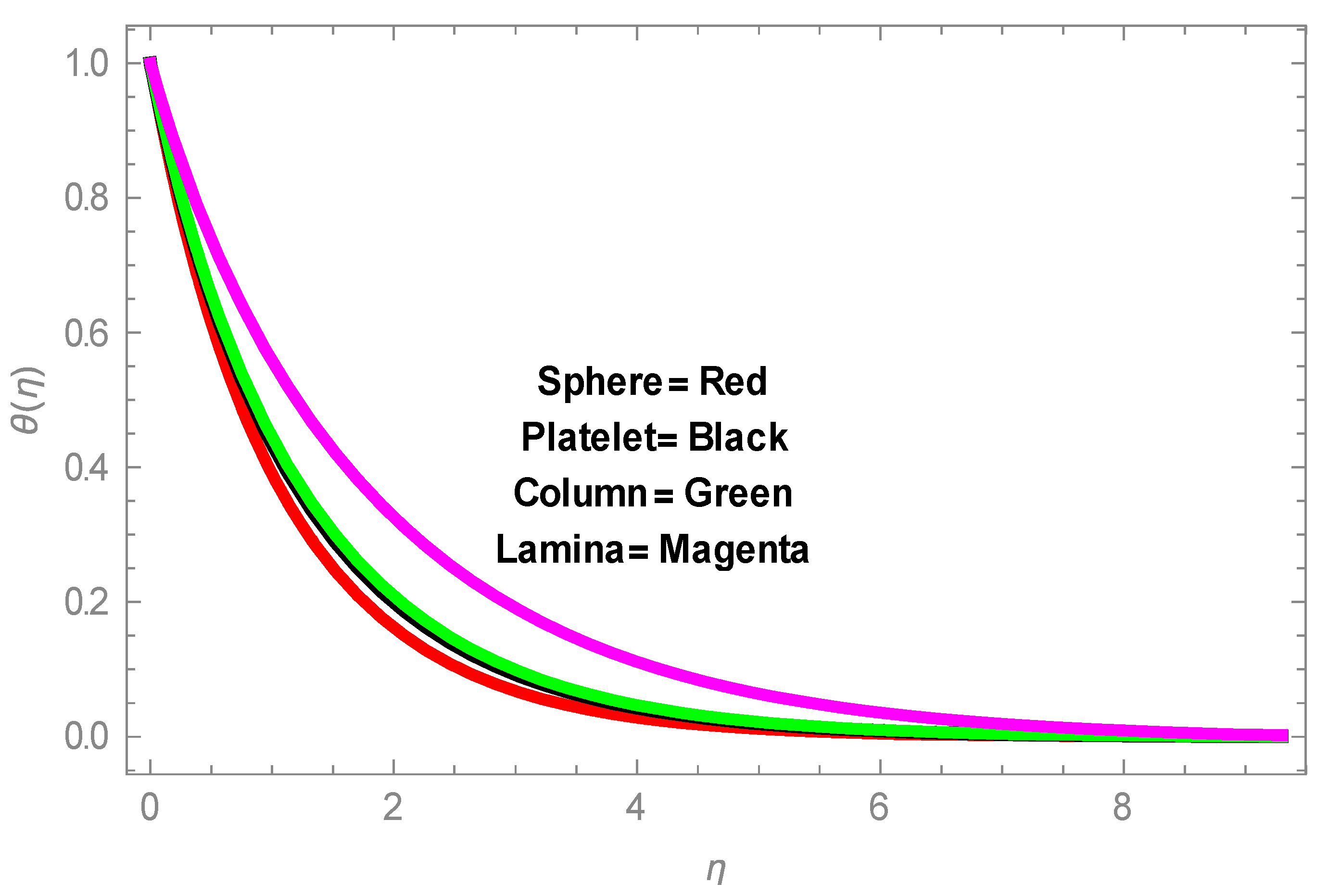

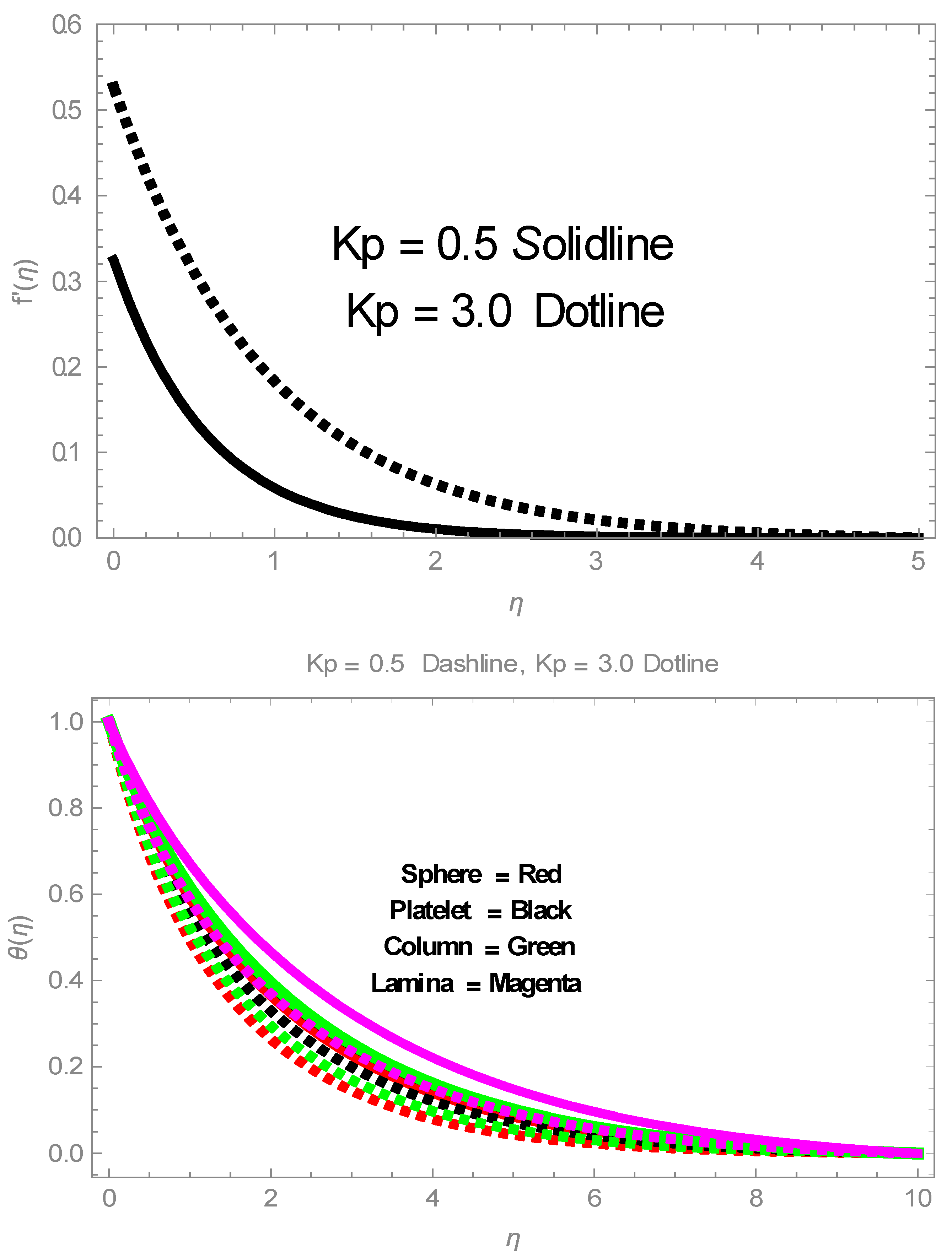



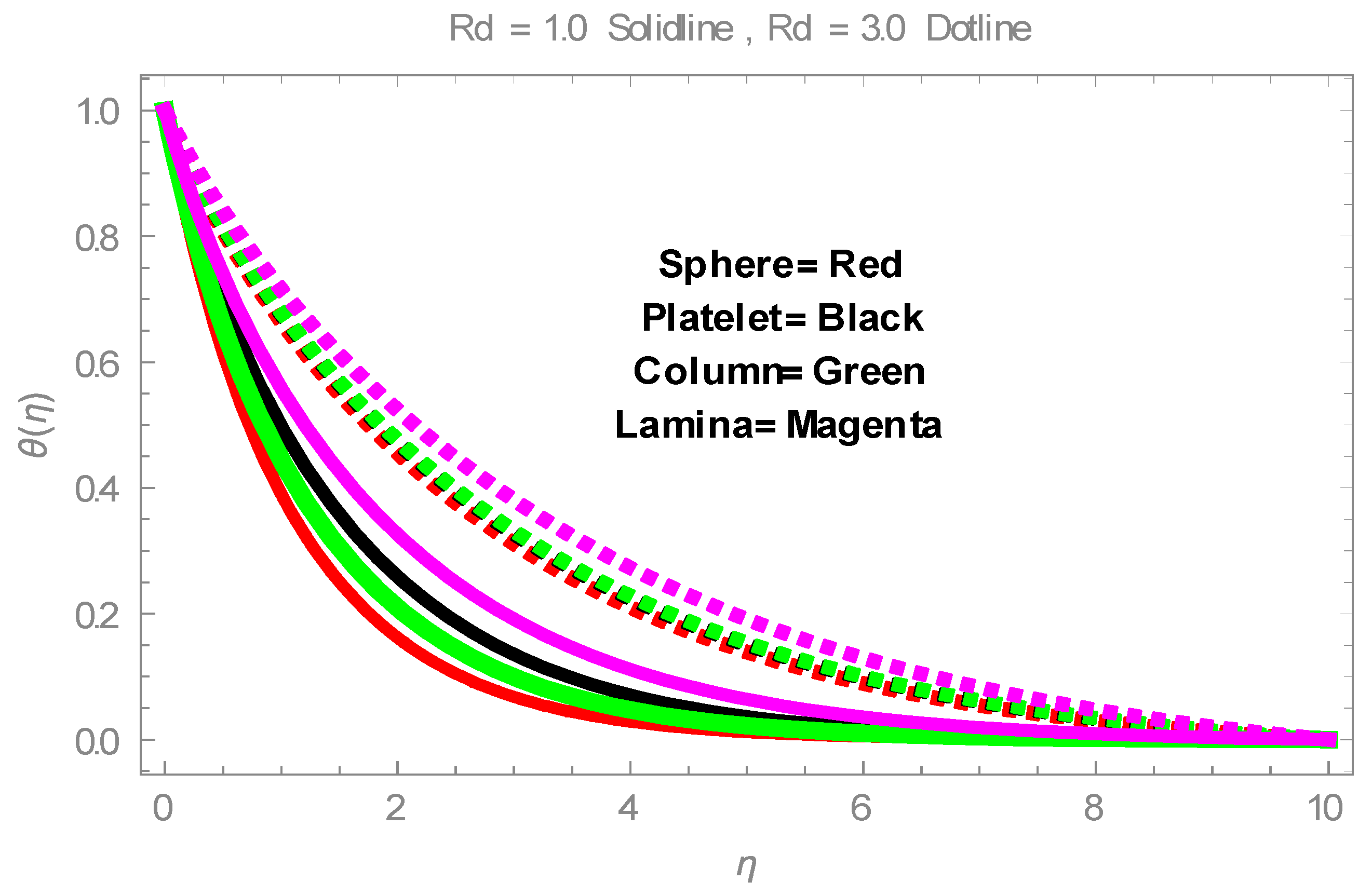
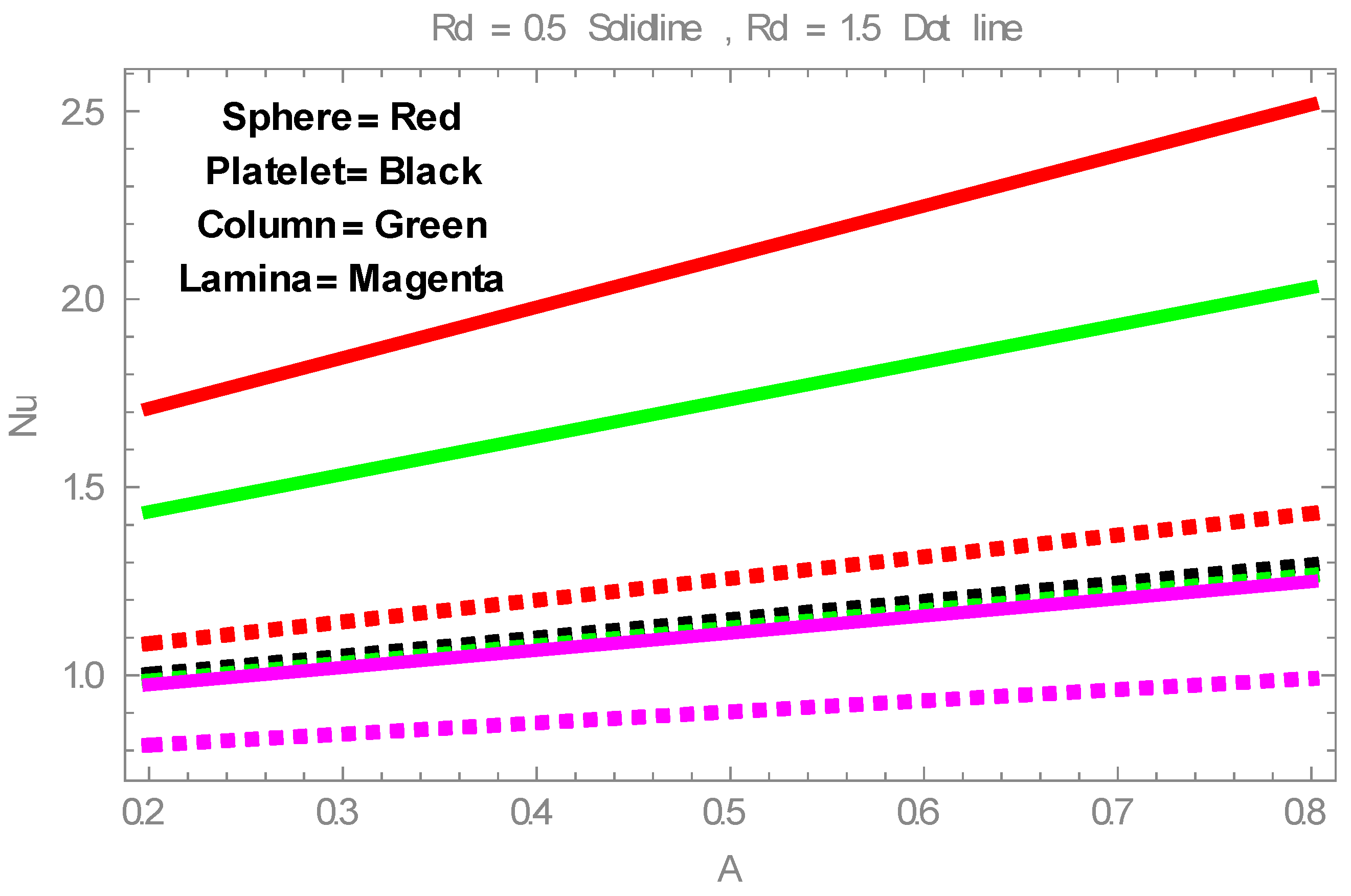
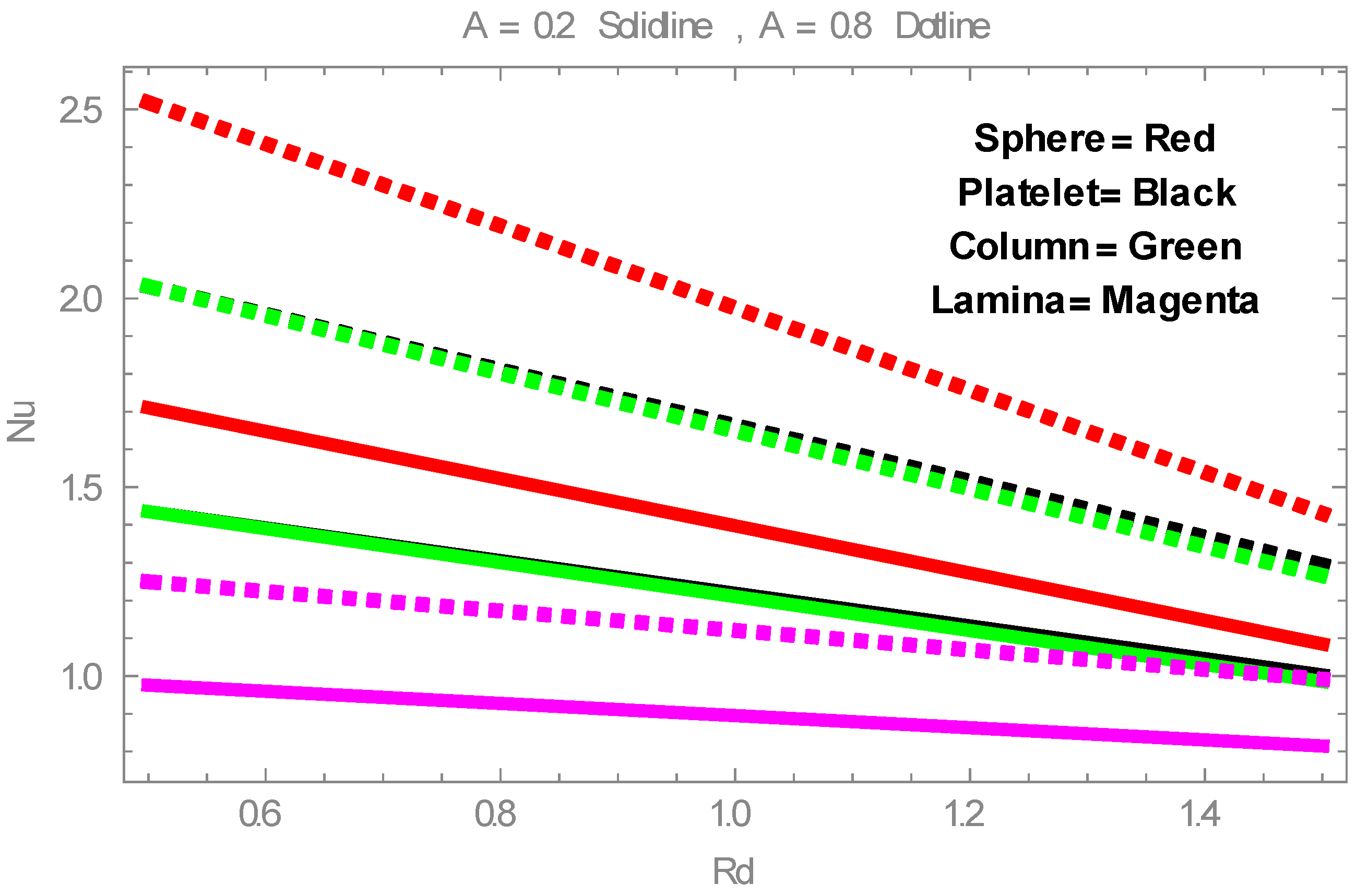

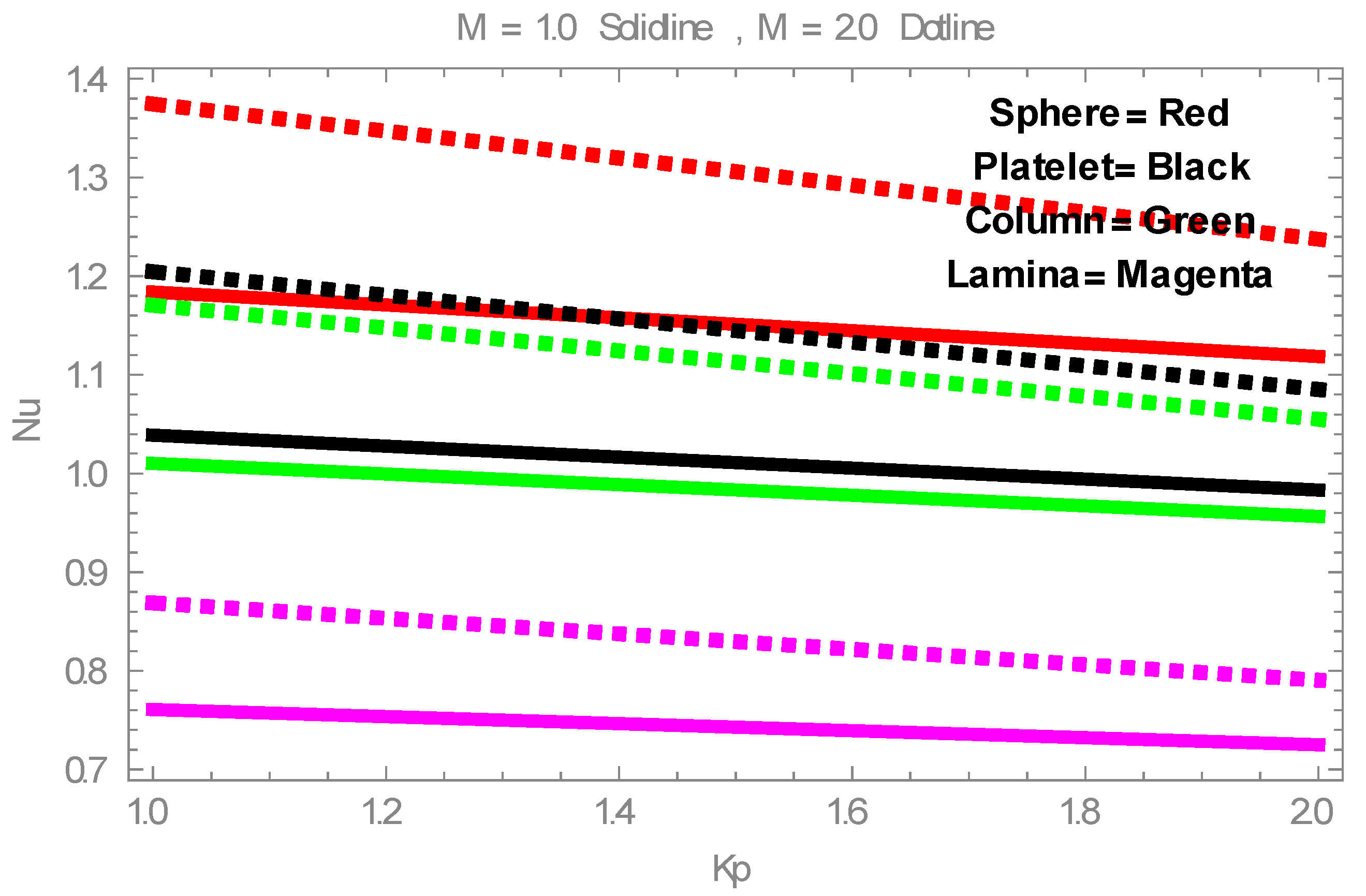


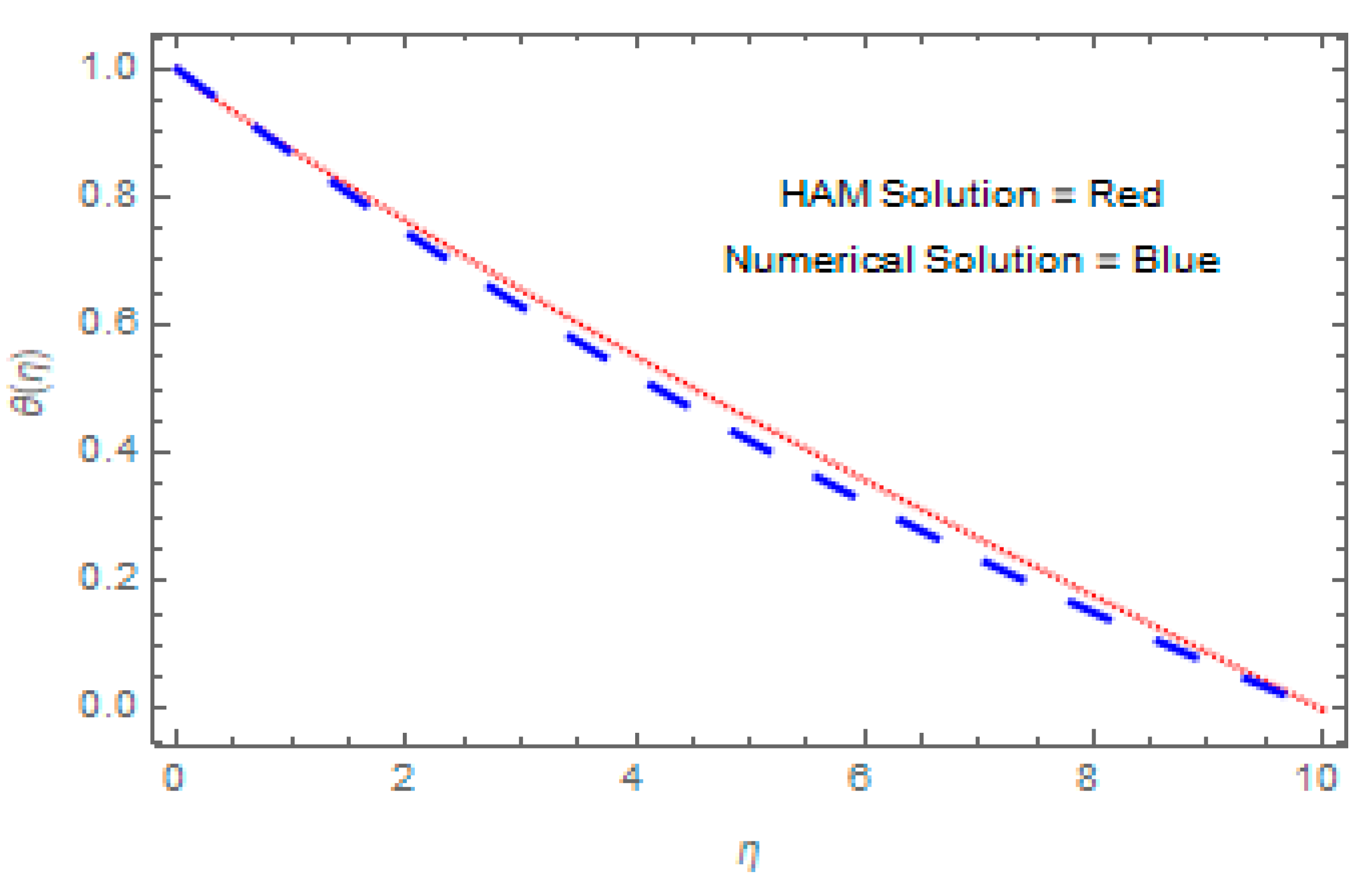
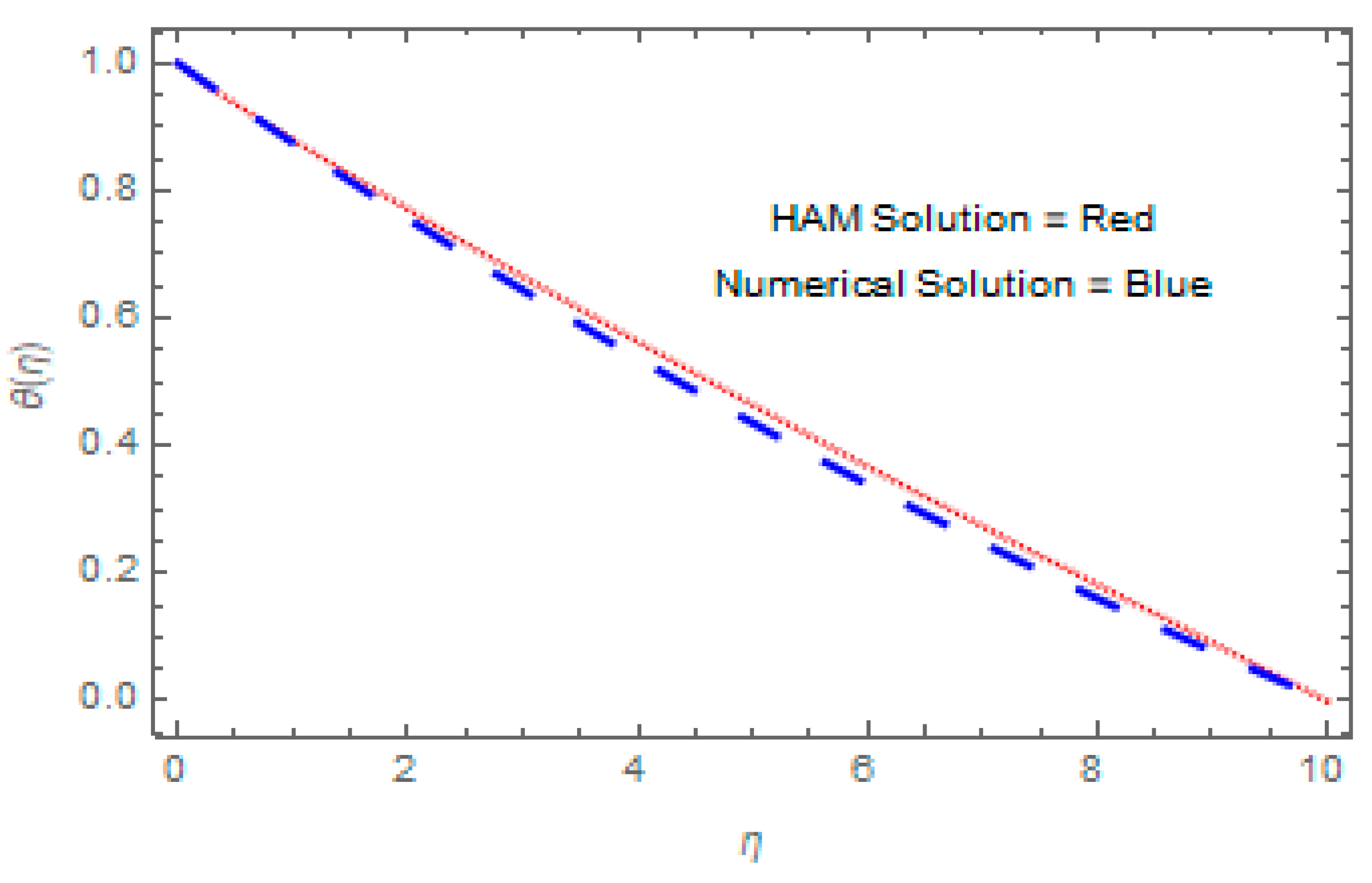
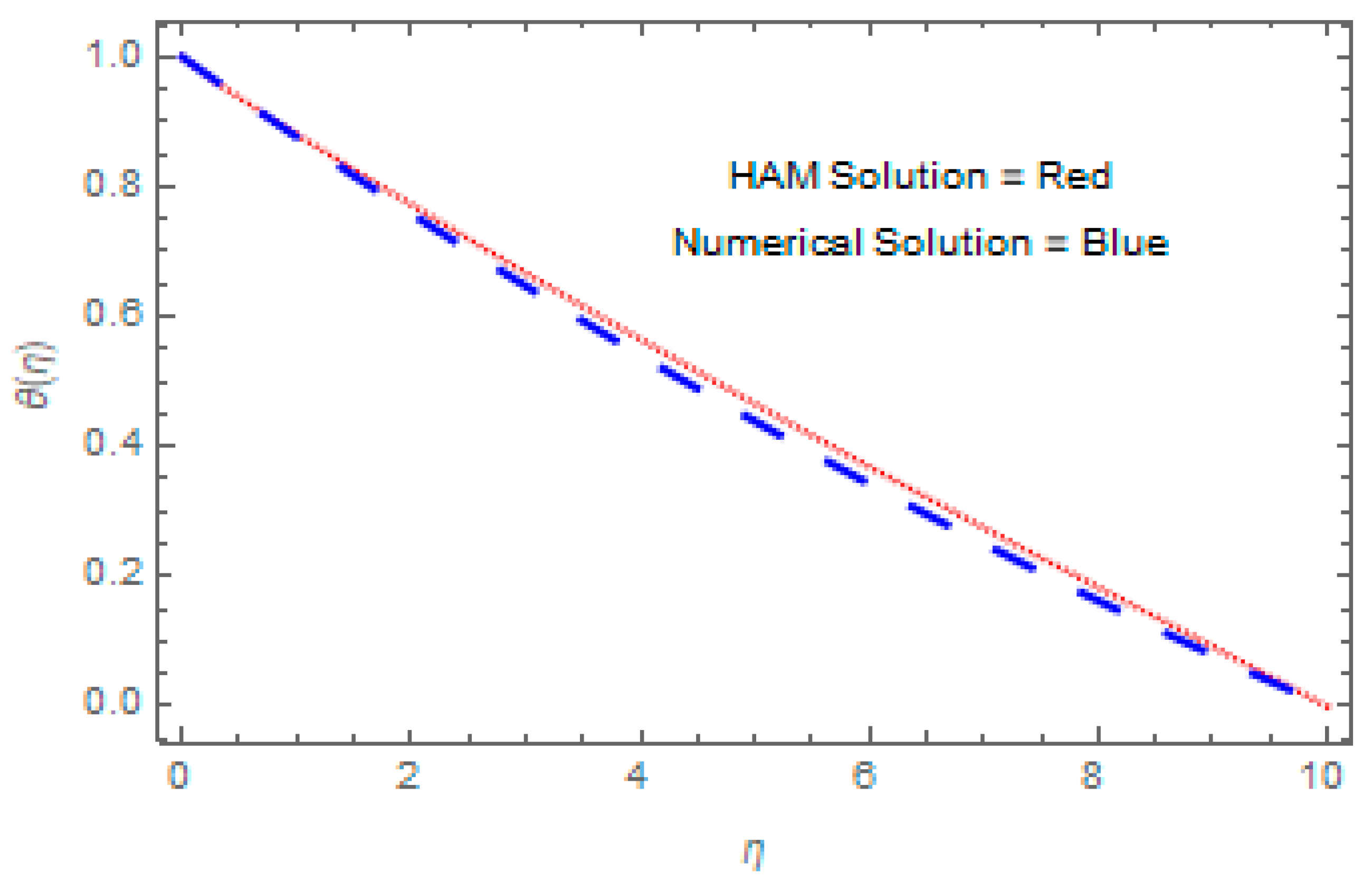
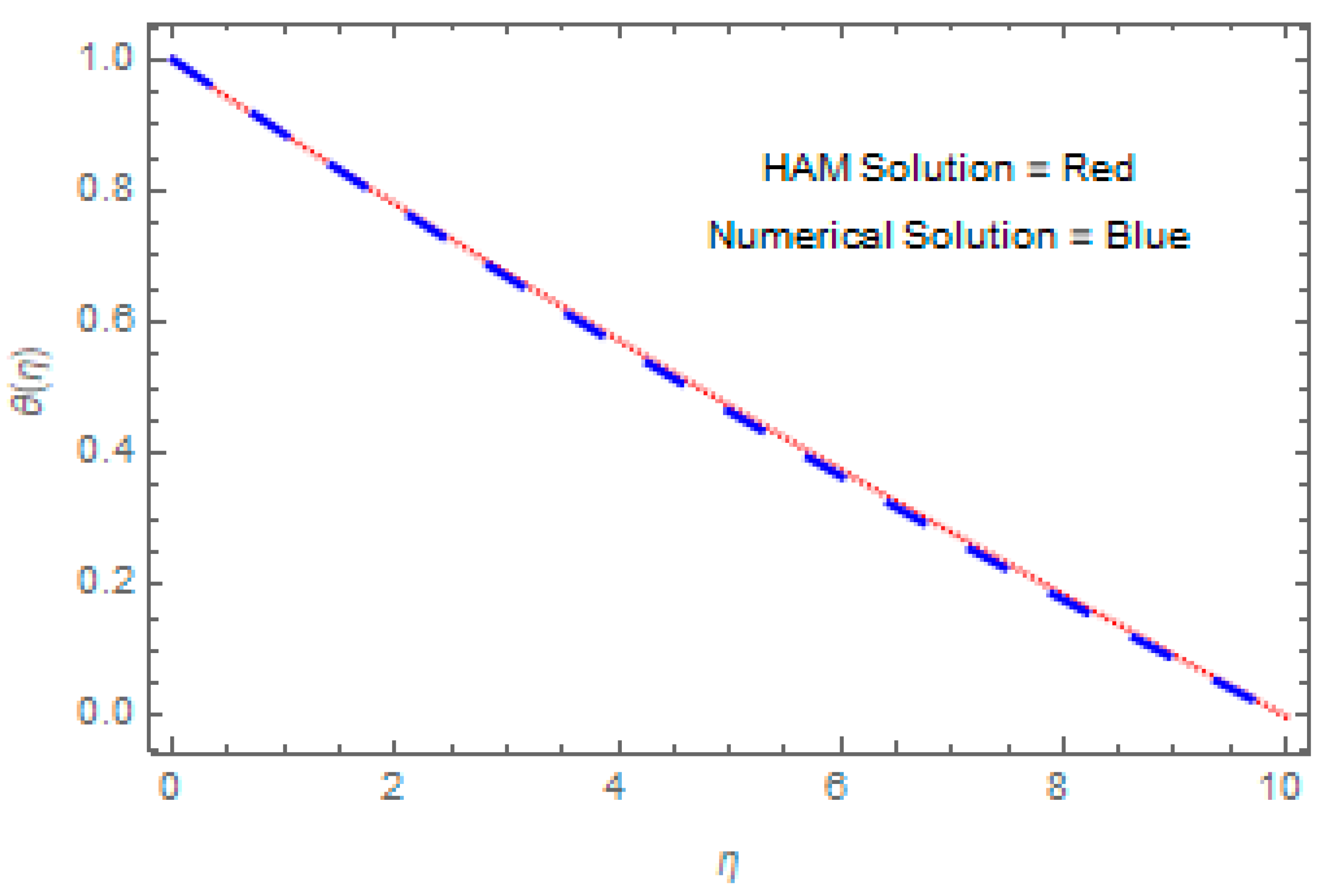
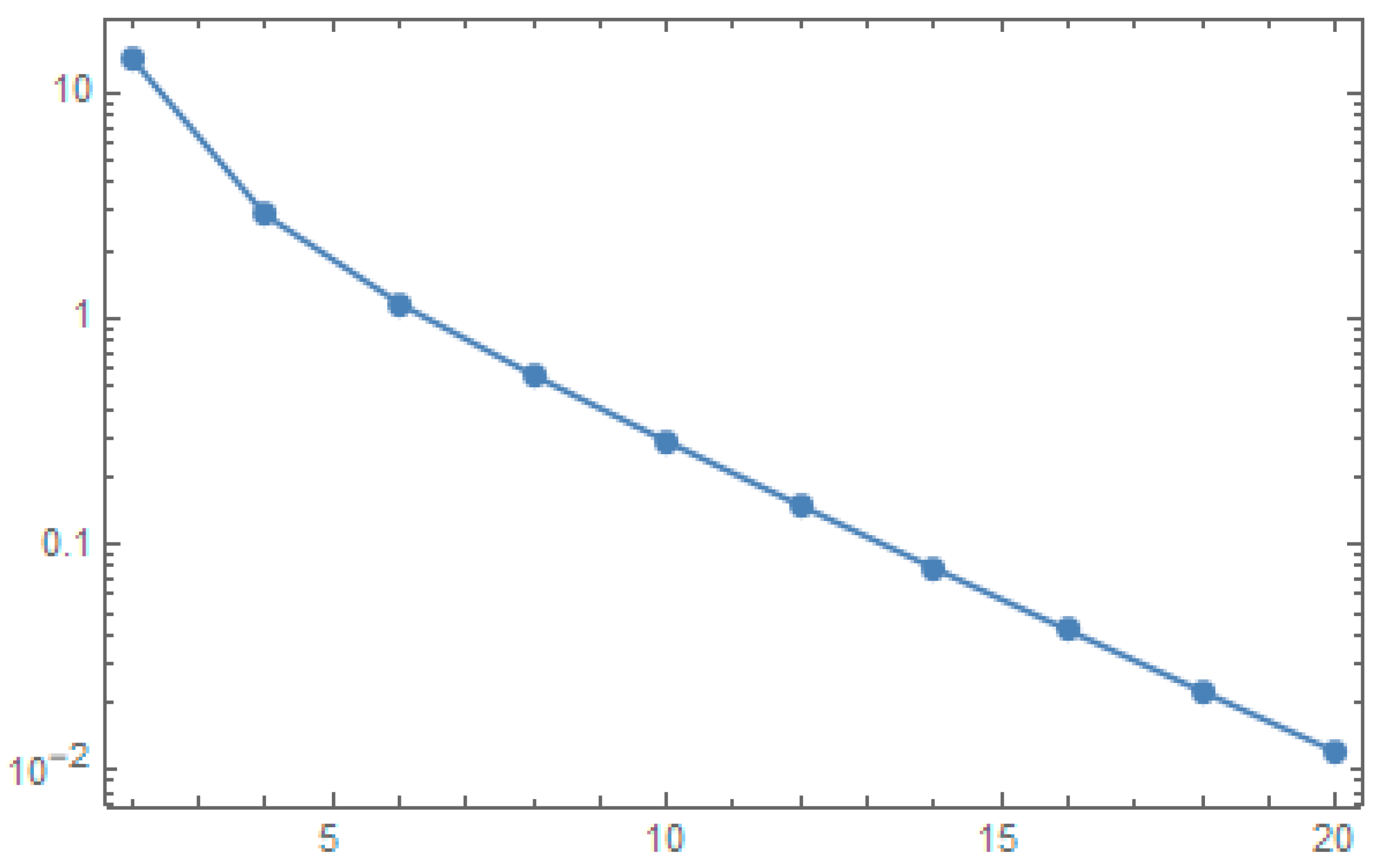
| Physical Properties | Graphene | Pure Water |
|---|---|---|
| Cp (J/kg K) | 2100 | 4179 |
| ρ (kg/m3) | 2250 | 997.1 |
| k (W/m K) | 2500 | 0.613 |
| (Ω m)−1 | 1 × 107 | 0.05 |
| Shape parameter | Column | Sphere | Platelet | Lamina |
|---|---|---|---|---|
| 0.4710 | 1 | 0.526 | 0.1857 | |
| m | 6.3698 | 3 | 5.7 | 16.1576 |
| HAM Results | Numerical Results | Absolute Error | |
|---|---|---|---|
| 0 | 1.000000 | 1.000000 | 0.000000 |
| 1 | 0.873762 | 0.868390 | 0.005372 |
| 2 | 0.762481 | 0.745049 | 0.017432 |
| 3 | 0.655491 | 0.629456 | 0.026035 |
| 4 | 0.552687 | 0.521125 | 0.031562 |
| 5 | 0.453964 | 0.419600 | 0.034365 |
| 6 | 0.358922 | 0.324453 | 0.034469 |
| 7 | 0.267190 | 0.235283 | 0.031907 |
| 8 | 0.177983 | 0.511715 | 0.026268 |
| 9 | 0.088937 | 0.073397 | 0.015540 |
| 10 | 0.000045 | −2.867620 × 10−16 | 0.000048 |
| HAM Results | Numerical Results | Absolute Error | |
|---|---|---|---|
| 0 | 1.000000 | 1.000000 | 2.22050 × 10−16 |
| 1 | 0.879780 | 0.875368 | 0.004413 |
| 2 | 0.77126 | 0.756973 | 0.014289 |
| 3 | 0.665913 | 0.644504 | 0.021409 |
| 4 | 0.563643 | 0.537663 | 0.025970 |
| 5 | 0.464400 | 0.436170 | 0.028230 |
| 6 | 0.367944 | 0.339756 | 0.028187 |
| 7 | 0.274100 | 0.248168 | 0.025932 |
| 8 | 0.182831 | 0.161164 | 0.021668 |
| 9 | 0.091886 | 0.078512 | 0.013374 |
| 10 | 0.000045 | −0.000012 | 0.0000057 |
| HAM Results | Numerical Results | Absolute Error | |
|---|---|---|---|
| 0 | 1.00000 | 1.00000 | 1.110220 × 10−16 |
| 1 | 0.880803 | 0.876647 | 0.0004157 |
| 2 | 0.772721 | 0.759171 | 0.013550 |
| 3 | 0.667628 | 0.647293 | 0.020335 |
| 4 | 0.565433 | 0.540745 | 0.024688 |
| 5 | 0.466112 | 0.439275 | 0.026849 |
| 6 | 0.369449 | 0.342639 | 0.026810 |
| 7 | 0.275239 | 0.250608 | 0.024631 |
| 8 | 0.183575 | 0.612962 | 0.020612 |
| 9 | 0.92388 | 0.079491 | 0.012897 |
| 10 | 0.000045 | −0.000015 | 0.0000060 |
| HAM Results | Numerical Results | Absolute Error | |
|---|---|---|---|
| 0 | 1.00000 | 1.00000 | 1.110220 × 10−16 |
| 1 | 0.886622 | 0.886708 | 0.000085 |
| 2 | 0.779944 | 0.776596 | 0.003348 |
| 3 | 0.675410 | 0.669576 | 0.005834 |
| 4 | 0.573134 | 0.565560 | 0.007574 |
| 5 | 0.473222 | 0.464464 | 0.008757 |
| 6 | 0.375596 | 0.366207 | 0.009272 |
| 7 | 0.279981 | 0.270708 | 0.009272 |
| 8 | 0.186039 | 0.177891 | 0.008148 |
| 9 | 0.923294 | 0.087678 | 0.005616 |
| 10 | 0.000045 | −0.000012 | 0.0000058 |
© 2020 by the authors. Licensee MDPI, Basel, Switzerland. This article is an open access article distributed under the terms and conditions of the Creative Commons Attribution (CC BY) license (http://creativecommons.org/licenses/by/4.0/).
Share and Cite
Rashid, U.; Baleanu, D.; Liang, H.; Abbas, M.; Iqbal, A.; Rahman, J.u. Marangoni Boundary Layer Flow and Heat Transfer of Graphene–Water Nanofluid with Particle Shape Effects. Processes 2020, 8, 1120. https://doi.org/10.3390/pr8091120
Rashid U, Baleanu D, Liang H, Abbas M, Iqbal A, Rahman Ju. Marangoni Boundary Layer Flow and Heat Transfer of Graphene–Water Nanofluid with Particle Shape Effects. Processes. 2020; 8(9):1120. https://doi.org/10.3390/pr8091120
Chicago/Turabian StyleRashid, Umair, Dumitru Baleanu, Haiyi Liang, Muhammad Abbas, Azhar Iqbal, and Jamshid ul Rahman. 2020. "Marangoni Boundary Layer Flow and Heat Transfer of Graphene–Water Nanofluid with Particle Shape Effects" Processes 8, no. 9: 1120. https://doi.org/10.3390/pr8091120
APA StyleRashid, U., Baleanu, D., Liang, H., Abbas, M., Iqbal, A., & Rahman, J. u. (2020). Marangoni Boundary Layer Flow and Heat Transfer of Graphene–Water Nanofluid with Particle Shape Effects. Processes, 8(9), 1120. https://doi.org/10.3390/pr8091120







